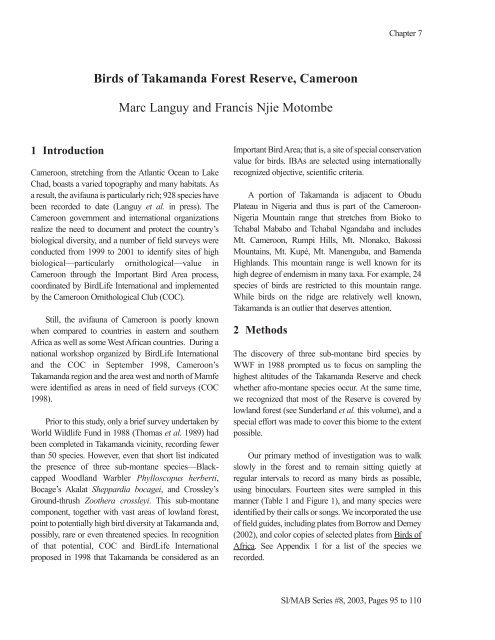Fisheries in the Southern Border Zone of Takamanda - Impact ...
Fisheries in the Southern Border Zone of Takamanda - Impact ...
Fisheries in the Southern Border Zone of Takamanda - Impact ...
You also want an ePaper? Increase the reach of your titles
YUMPU automatically turns print PDFs into web optimized ePapers that Google loves.
1 Introduction<br />
Birds <strong>of</strong> <strong>Takamanda</strong> Forest Reserve, Cameroon<br />
Marc Languy and Francis Njie Motombe<br />
Cameroon, stretch<strong>in</strong>g from <strong>the</strong> Atlantic Ocean to Lake<br />
Chad, boasts a varied topography and many habitats. As<br />
a result, <strong>the</strong> avifauna is particularly rich; 928 species have<br />
been recorded to date (Languy et al. <strong>in</strong> press). The<br />
Cameroon government and <strong>in</strong>ternational organizations<br />
realize <strong>the</strong> need to document and protect <strong>the</strong> country’s<br />
biological diversity, and a number <strong>of</strong> field surveys were<br />
conducted from 1999 to 2001 to identify sites <strong>of</strong> high<br />
biological—particularly ornithological—value <strong>in</strong><br />
Cameroon through <strong>the</strong> Important Bird Area process,<br />
coord<strong>in</strong>ated by BirdLife International and implemented<br />
by <strong>the</strong> Cameroon Ornithological Club (COC).<br />
Still, <strong>the</strong> avifauna <strong>of</strong> Cameroon is poorly known<br />
when compared to countries <strong>in</strong> eastern and sou<strong>the</strong>rn<br />
Africa as well as some West African countries. Dur<strong>in</strong>g a<br />
national workshop organized by BirdLife International<br />
and <strong>the</strong> COC <strong>in</strong> September 1998, Cameroon’s<br />
<strong>Takamanda</strong> region and <strong>the</strong> area west and north <strong>of</strong> Mamfe<br />
were identified as areas <strong>in</strong> need <strong>of</strong> field surveys (COC<br />
1998).<br />
Prior to this study, only a brief survey undertaken by<br />
World Wildlife Fund <strong>in</strong> 1988 (Thomas et al. 1989) had<br />
been completed <strong>in</strong> <strong>Takamanda</strong> vic<strong>in</strong>ity, record<strong>in</strong>g fewer<br />
than 50 species. However, even that short list <strong>in</strong>dicated<br />
<strong>the</strong> presence <strong>of</strong> three sub-montane species—Blackcapped<br />
Woodland Warbler Phylloscopus herberti,<br />
Bocage’s Akalat Sheppardia bocagei, and Crossley’s<br />
Ground-thrush Zoo<strong>the</strong>ra crossleyi. This sub-montane<br />
component, toge<strong>the</strong>r with vast areas <strong>of</strong> lowland forest,<br />
po<strong>in</strong>t to potentially high bird diversity at <strong>Takamanda</strong> and,<br />
possibly, rare or even threatened species. In recognition<br />
<strong>of</strong> that potential, COC and BirdLife International<br />
proposed <strong>in</strong> 1998 that <strong>Takamanda</strong> be considered as an<br />
Important Bird Area; that is, a site <strong>of</strong> special conservation<br />
value for birds. IBAs are selected us<strong>in</strong>g <strong>in</strong>ternationally<br />
recognized objective, scientific criteria.<br />
A portion <strong>of</strong> <strong>Takamanda</strong> is adjacent to Obudu<br />
Plateau <strong>in</strong> Nigeria and thus is part <strong>of</strong> <strong>the</strong> Cameroon-<br />
Nigeria Mounta<strong>in</strong> range that stretches from Bioko to<br />
Tchabal Mababo and Tchabal Ngandaba and <strong>in</strong>cludes<br />
Mt. Cameroon, Rumpi Hills, Mt. Nlonako, Bakossi<br />
Mounta<strong>in</strong>s, Mt. Kupé, Mt. Manenguba, and Bamenda<br />
Highlands. This mounta<strong>in</strong> range is well known for its<br />
high degree <strong>of</strong> endemism <strong>in</strong> many taxa. For example, 24<br />
species <strong>of</strong> birds are restricted to this mounta<strong>in</strong> range.<br />
While birds on <strong>the</strong> ridge are relatively well known,<br />
<strong>Takamanda</strong> is an outlier that deserves attention.<br />
2 Methods<br />
Chapter 7<br />
The discovery <strong>of</strong> three sub-montane bird species by<br />
WWF <strong>in</strong> 1988 prompted us to focus on sampl<strong>in</strong>g <strong>the</strong><br />
highest altitudes <strong>of</strong> <strong>the</strong> <strong>Takamanda</strong> Reserve and check<br />
whe<strong>the</strong>r afro-montane species occur. At <strong>the</strong> same time,<br />
we recognized that most <strong>of</strong> <strong>the</strong> Reserve is covered by<br />
lowland forest (see Sunderland et al. this volume), and a<br />
special effort was made to cover this biome to <strong>the</strong> extent<br />
possible.<br />
Our primary method <strong>of</strong> <strong>in</strong>vestigation was to walk<br />
slowly <strong>in</strong> <strong>the</strong> forest and to rema<strong>in</strong> sitt<strong>in</strong>g quietly at<br />
regular <strong>in</strong>tervals to record as many birds as possible,<br />
us<strong>in</strong>g b<strong>in</strong>oculars. Fourteen sites were sampled <strong>in</strong> this<br />
manner (Table 1 and Figure 1), and many species were<br />
identified by <strong>the</strong>ir calls or songs. We <strong>in</strong>corporated <strong>the</strong> use<br />
<strong>of</strong> field guides, <strong>in</strong>clud<strong>in</strong>g plates from Borrow and Demey<br />
(2002), and color copies <strong>of</strong> selected plates from Birds <strong>of</strong><br />
Africa. See Appendix 1 for a list <strong>of</strong> <strong>the</strong> species we<br />
recorded.<br />
SI/MAB Series #8, 2003, Pages 95 to 110

















